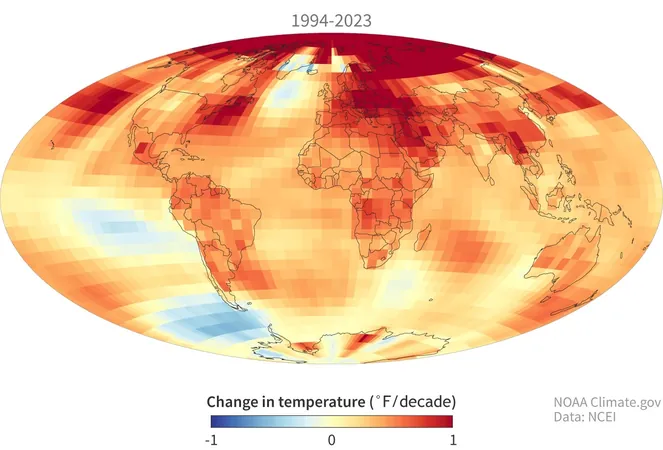
How Advanced Civilizations Risk Overheating Their Planets in Just 1,000 Years!
2024-09-21
Author: Yu
Introduction
As the Earth continues to heat up at an alarming rate, recent studies indicate that advanced civilizations may be on a trajectory to render their home planets uninhabitable within the next millennium. According to the National Oceanic and Atmospheric Administration (NOAA), global temperatures have been climbing steadily since the Industrial Revolution, currently rising by about 0.06 °C (0.11 °F) per decade, and projections suggest an increase of between 1.5 and 2 °C (2.7 to 3.6 °F) by mid-century. This escalating temperature rise is primarily driven by excessive fossil fuel consumption, which has surged since the mid-19th century.
The Link Between Energy Consumption and Habitability
The implications of climate change aren’t just a local concern for Earth; they resonate deeply within the field of astrobiology, particularly when examining the long-term fate of advanced civilizations in the universe. In a groundbreaking study led by researchers Amedeo Balbi from the Universita di Roma Tor Vergata and Manasvi Lingam from the Florida Institute of Technology, the consequences of growing energy consumption on planetary habitability have been assessed. Their paper, “Waste Heat and Habitability: Constraints from Technological Energy Consumption,” has gained attention for its alarming conclusions.
Waste Heat and Climate Impact
Rooted in the theories of Soviet scientist Mikhail I. Budyko, the research suggests that not only fossil fuel emissions contribute to the impending crisis; the relentless growth of energy consumption itself produces waste heat that could exacerbate global warming significantly over time. While current waste heat contributions to global warming might seem minimal, projections reveal that, if energy consumption continues to soar, this could lead to up to an additional 1°C (1.8°F) rise in temperature purely from waste heat.
Illustration of the Crisis: The Dyson Sphere
A striking illustration of this phenomenon is encapsulated in the concept of a Dyson Sphere—an advanced megastructure hypothesized to encircle a star to harvest its energy. Such civilizations would generate substantial waste heat as they convert starlight into energy, pushing their home planets toward inhospitable conditions.
Civilizational Lifespan and Energy Consumption
Balbi and Lingam's study utilized thermodynamic principles to estimate how long would it take for civilizations to make their planets uninhabitable. They examined the circumsolar habitable zone (CHZ)—regions around stars where conditions are right for liquid water. By analyzing humanity's rapid energy consumption growth from just 5,653 terawatt-hours (TWh) in 1800 to a staggering 183,230 TWh in 2023, they projected that a technologically mature civilization's lifetime could dwindle to roughly 1,000 years if it maintained a mere 1% annual growth rate.
Implications for Humanity and SETI
The implications of this research are profound, especially regarding humanity's future and the ongoing Search for Extraterrestrial Intelligence (SETI). As advanced civilizations potentially march toward self-destruction, the findings prompt vital considerations for how we search for signs of life elsewhere in the universe. Could the Fermi Paradox—why we haven’t detected other advanced civilizations—partially stem from this phenomenon of self-induced planetary overheating?
Solutions and Sustainability
Moreover, Balbi and Lingam encourage a new lens through which we can view both our current predicaments and the challenges faced by hypothetical extraterrestrial life forms. Suggesting that solutions might exist—such as utilizing stellar shielding technology or relocating infrastructure off-world—the researchers stress that embracing a more sustainable energy consumption model could very well be the key to survival on our planet.
Conclusion
As we face the reality of climate change, it’s crucial to not just learn from these theoretical frameworks but to act decisively to avoid such a grim fate. The extra-terrestrial civilizations who may have already faced and resolved similar challenges may hold crucial answers, and it’s our mission to explore those possibilities before it’s too late. Could the answers to our survival and the secrets of the cosmos lie in understanding the delicate balance between energy consumption and planetary health? Time will tell, but the clock is ticking!




 Brasil (PT)
Brasil (PT)
 Canada (EN)
Canada (EN)
 Chile (ES)
Chile (ES)
 Česko (CS)
Česko (CS)
 대한민국 (KO)
대한민국 (KO)
 España (ES)
España (ES)
 France (FR)
France (FR)
 Hong Kong (EN)
Hong Kong (EN)
 Italia (IT)
Italia (IT)
 日本 (JA)
日本 (JA)
 Magyarország (HU)
Magyarország (HU)
 Norge (NO)
Norge (NO)
 Polska (PL)
Polska (PL)
 Schweiz (DE)
Schweiz (DE)
 Singapore (EN)
Singapore (EN)
 Sverige (SV)
Sverige (SV)
 Suomi (FI)
Suomi (FI)
 Türkiye (TR)
Türkiye (TR)
 الإمارات العربية المتحدة (AR)
الإمارات العربية المتحدة (AR)